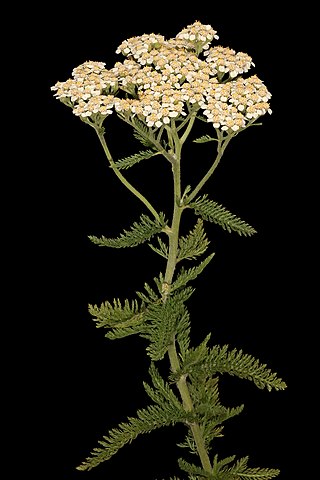
Achillea millefolium, commonly known as yarrow or common yarrow, is a flowering plant in the family Asteraceae. Other common names include old man's pepper, devil's nettle, sanguinary, milfoil, soldier's woundwort, and thousand seal.

Adelaide Island is a large, mainly ice-covered island, 139 kilometres (75 nmi) long and 37 kilometres (20 nmi) wide, lying at the north side of Marguerite Bay off the west coast of the Antarctic Peninsula. The Ginger Islands lie off the southern end. Mount Bodys is the easternmost mountain on Adelaide Island, rising to over 1,220 m. The island lies within the Argentine, British and Chilean Antarctic claims.

Haplotinea is a very small genus of fungus moths. Its subfamily among the fungus moths is disputed – many assign it to the Myrmecozelinae, but other authors have placed it in subfamily Nemapogoninae or Perissomasticinae. In all, its relationships are barely better resolved at present than those of the many Tineidae incertae sedis.

Lampronia corticella, the raspberry moth, is a moth of the family Prodoxidae. The species was first described by Carl Linnaeus in his 1758 10th edition of Systema Naturae. It is found in most of Europe, except Iceland, the Iberian Peninsula and the Balkan Peninsula. It is an introduced species in North America, where it was first detected in New Brunswick, Canada, in 1936.

Epinotia demarniana is a moth of the family Tortricidae found in most of Europe, east to the eastern part of the Palearctic realm.

Epermenia illigerella is a moth of the family Epermeniidae. It is known from most of Europe, as well as western Siberia and the Altai region.
Epermenia strictellus is a moth of the family Epermeniidae. It is found in Europe, as well as in North Africa, from Turkey, through Kyrgyzstan and the Tuva Region to Japan.

Chionodes continuella is a moth of the family Gelechiidae. It is found from most of Europe, east to Japan. It is also present in most of North America.
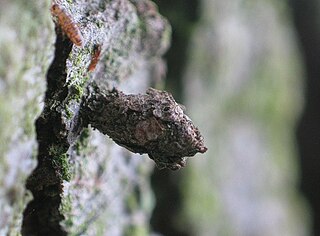
Bacotia claustrella, the shining smoke, is a moth of the Psychidae family. It is found in large parts of Europe, except Ireland, Norway, Finland, the Baltic region, Ukraine, the western and southern part of the Balkan Peninsula and the Iberian Peninsula.

Denisia stipella is a moth of the family Oecophoridae. It is found in almost all of continental Europe, except the Iberian Peninsula and the southern part of the Balkan Peninsula.
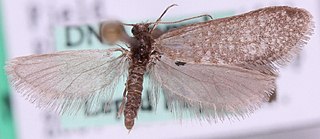
Siederia listerella is a moth of the Psychidae family. It was described by Carl Linnaeus in 1758. It is found in most of Europe, except Ireland, Great Britain, the Iberian Peninsula and most of the Balkan Peninsula.
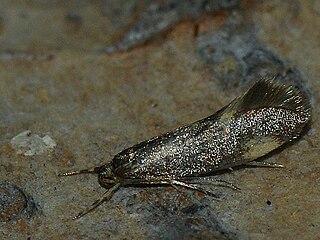
Metalampra cinnamomea is a moth of the family Oecophoridae. It was described by Philipp Christoph Zeller in 1839. It is found in most of Europe, except the Iberian Peninsula, most of the Balkan Peninsula, Ireland and Great Britain.

Cochylidia subroseana, the dingy roseate conch, is a moth of the family Tortricidae. It was described by Adrian Hardy Haworth in 1811. It is found from most of Europe to China, Russia, Korea and Japan. It has also been recorded from North America.

Haplotinea insectella, the drab clothes moth or fungus grain moth, is a moth of the family Tineidae. It was described by Johan Christian Fabricius in 1794. It is found in all of Europe, except Ireland, the Iberian Peninsula and the western and southern part of the Balkan Peninsula. It is also found in North America. The species is often found in warehouses, granaries, mills and farm buildings.

Infurcitinea ignicomella is a moth of the family Tineidae. It was described by Heydenreich in 1851. It is found in large parts of Europe, except Ireland, Great Britain, Belgium, the Iberian Peninsula, Ukraine and most of the Balkan Peninsula.

Infurcitinea argentimaculella, the silver-barred clothes moth, is a moth of the family Tineidae. It was described by Stainton in 1849. It is found in most of Europe, except Ireland, Portugal, Latvia, Lithuania and the Balkan Peninsula.
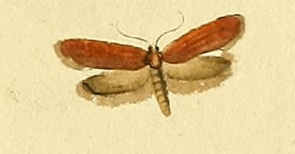
Crassa tinctella, the tinted tubic, is a moth of the family Oecophoridae. It was described by Jacob Hübner in 1796. It is found in most of Europe, except Ireland, the Iberian Peninsula and most of the Balkan Peninsula.
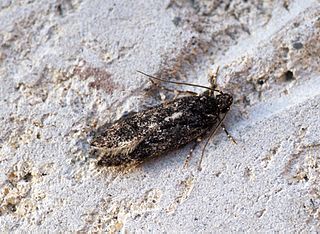
Gelechia nigra, the black groundling, is a moth of the family Gelechiidae. It was described by Adrian Hardy Haworth in 1828. It is found in most of Europe, except Ireland, the Iberian Peninsula and most of the Balkan Peninsula. The habitat consists of woodlands and river banks.

The Myrmecozelinae are a subfamily of moth of the family Tineidae.

















